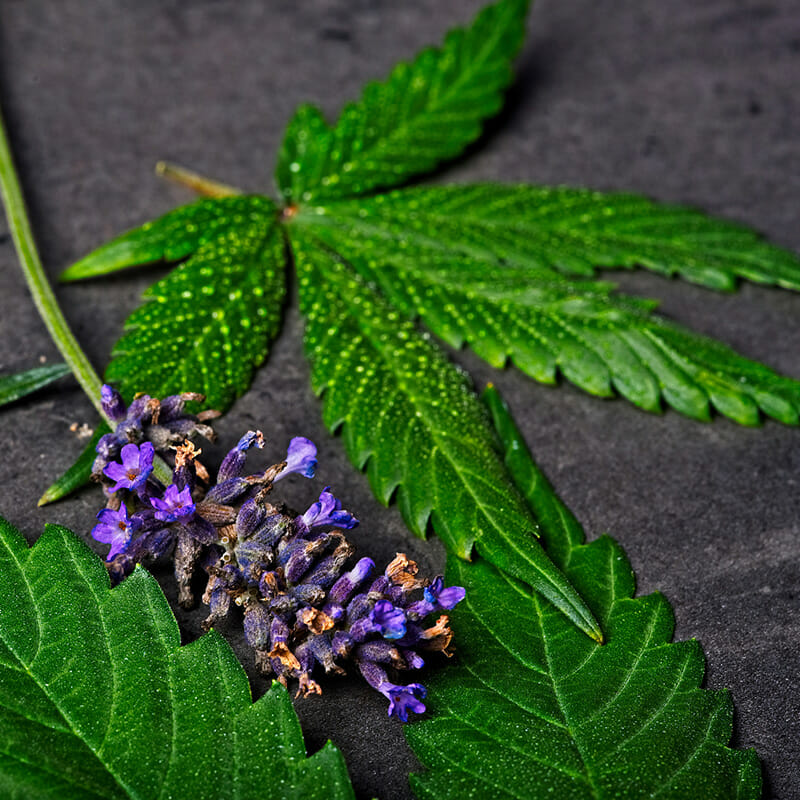Understanding Cannabis Terpenes
Written by Chris Weatherall on Jan 8, 2021
Have you ever wondered why different strains of cannabis have such different aromas? Many popular strains can be characterized by their smell. You might have noticed how some strains have an earthy note. Others smell a little cheesy and some more spicy or floral. These aromas are caused by naturally occurring chemical compounds called terpenes, which are found in most plants and are responsible for giving them their odor. If you’ve ever wondered what gives pine trees their unique scent or what makes orange peels smell so intense, it’s because of the terpenes. Most plants contain a variety of terpenes, and cannabis has over 100.
You are aware of terpenes, even if you don’t know it. Terpenes are the chemical compounds responsible for making certain plants smell the way they do. For example, terpenes give orange peels their citrusy smell and conifers their characteristic piney odor. In nature, terpenes help plants by protecting them from grazing animals and harmful germs and bacteria, while terpenes help other plants and trees by attracting pollinators and seed spreaders like bees and birds. Manufacturers also use isolated terpenes to create certain smells used in cosmetics, body products, and perfumes. Terpenes are even used to produce certain smells and flavors in foods.
What Are Terpenes and How Do They Work?

The cannabis terpene structure is complex. Terpenes are a volatile organic chemical compound produced by many plants and even some animals. Chemically, terpenes are derived from the union of five carbon atoms in the compound isoprene. When isoprene molecules join together, they form terpenes.
Terpenes are responsible for giving plants their aromas and producing resin. Because terpenes are largely responsible for making resin, they can be used to produce many essential oils. Terpenes are a common ingredient in alternative medicine practice and aromatherapy. For example, many people use various essential oils or oil diffusers to produce a certain mood or physical response. For example, lavender essential oil often makes people feel relaxed and soothes headaches, while citrus is used to energize and uplift. These reactions we get from essential oils are due to the presence of terpenes.
Are Terpenes and Terpenoids the Same?
The words “terpene” and “terpenoid” are often used interchangeably, but in fact, there are some differences. While terpenes are the naturally-occurring, chemical compound found in living plants, terpenoids refer to terpenes that have been oxidized. Oxidization usually occurs when a plant dies and is dried. For example, terpenes are converted to terpenoids in cannabis production during the drying and curing process. Since they are so prevalent in cannabis, some may wonder: do terpenes get you high? The answer is no, although they have a number of other benefits.
How Are Terpenes Different from Cannabinoids?

Cannabinoids refer to many different chemical compounds found in cannabis. Some cannabinoids are present in other plant species as well. For example, the cannabinoid compound lipophilic alkoxides are abundant in Echinacea plants.
While there are a least 113 different types of cannabinoid compounds derived from the cannabis plant, there are two which many people are familiar with: tetrahydrocannabinol (THC), the psychoactive component of the plant, and cannabidiol (CBD), a non-psychoactive component. Cannabinoids affect us through the cannabidiol receptors found in the brain and immune system of most mammals, fish, and birds.
Terpenes and Cannabinoids Effects
Cannabinoids are the compounds in cannabis that promote healing and other health benefits. But did you know that terpenes play a big role in the healing properties of cannabis as well?
Usually, when we consume cannabis, we consume the flower. Most flowers have a unique smell caused by the various terpenes present in the plant, and the cannabis flower is no exception. You know how different strains often have a unique smell? Some might have an earthy odor, and some floral, others might even smell like French cheese—and so on. While the terpenes in cannabis do not have any psychoactive properties, they have other benefits.
Similar to how different smells can affect a person’s mood, many people believe that different terpenes can affect and influence the type of “high” you experience when using cannabis. This process is known as the “Entourage Effect.”
The Entourage Effect

The “Entourage Effect” is a term some researchers use to describe the synergy between cannabinoids, terpenes, and flavonoids. Although the research has not yet been confirmed, many scientists believe that the specific combinations of terpenes and cannabinoids give cannabis much of its power. The terpenes work along with cannabinoids like THC and CBD to create a stronger effect than either would have on its own. Some researchers even believe that this symbiosis helps with the absorption of the cannabinoids into our system by overcoming bacterial defense mechanisms and limiting possible side effects.
Terpenes might also influence the specific ways in which cannabis users are affected. Different strains of cannabis are known to produce varying sensations and moods. Certain strains promote sleep and relaxation. Others stimulate focus, while others reduce anxiety. Researchers believe these varied responses are due to the reaction between cannabinoids and terpenes. Just like terpenes in essential oils are used to alter mood (such as lavender for relaxation), terpenes in cannabis can be used to alter mood, as well. Terpenes are present in CBD, too, and there are many CBD terpenes benefits.
Terpene Benefits and a List of the Ten Most Common Terpenes
As we mentioned before, there are over 100 varieties of cannabinoids found in the cannabis plant. We won’t go over all 113 types, but only the top 10.

1. Myrcene
Myrcene is the most prevalent terpene found in cannabis. In fact, research shows that myrcene makes up around 65% of the terpene profile of many strains. Myrcene is characterized by a deep, earthy, musky odor similar to cloves. Strains that produce large amounts of this terpene are usually Indica’s and have a sedative effect. Myrcene can be useful in reducing inflammation and chronic pain. This terpene isn’t only found in cannabis, though. Mangoes are also high in this compound.

2. Limonene
While not all strains contain limonene, it is the second most prevalent terpene found in cannabis. As the name suggests, limonene has a lemony, citrus-like odor. In fact, citrus fruits also produce large amounts of this terpene. Most cannabis strains with words like “sour,” “citrus,” or “lemon” in their name contain higher limonene levels. Limonene is believed to improve mood and reduce stress. This compound is also frequently used in cleaning products and cosmetics.

3. Linalool
Next on the list is linalool. This terpene has spicy, floral notes. This compound is not limited to the cannabis plant and is also found in herbs like coriander, cinnamon, lavender, and mint. Strains containing this terpene usually have a calming, sedative effect.

4. Caryophyllene
This terpene is characterized by its spicy, peppery notes. It is also found in herbs like black pepper, cinnamon, cloves, rosemary, basil, and oregano. Caryophyllene is unique, being the only terpene that binds to cannabinoid receptors. Due to its binding properties, caryophyllene is also commonly used in anti-inflammatory creams.

5. Alpha-pinene and Beta-pinene
As you might guess, these two terpenes are known for their piney smell. And yes, both terpenes are found in pine trees. This compound is particularly complimentary in conjugation with cannabinoids for several reasons. Alpha-pinene and Beta-pinene help improve airflow and respiratory function, as well as helping reduce memory loss related to THC.

6. Alpha-bisabolol
This terpene compound is typically found in chamomile flowers and candeia trees. It is known for its floral aromas and is most typically used in cosmetics and body products. However, it is also present in many cannabis strains. Some research shows that in cannabis, this terpene contains anti-irritation and analgesic properties.

7. Eucalyptol
Eucalyptol is present in small amounts in some cannabis strains but is most predominantly found in Eucalyptus trees. This terpene is responsible for those cooling and minty smells we associate with eucalyptus. Eucalyptus is known for its pain-relieving properties, which may also be present in cannabis strains containing the terpene eucalyptol.

8. Trans-nerolidol
This terpene is mostly found in flowers. It is abundant in plants such as Jasmine, Lemongrass, and Tea-Tree. It is known for having citrussy, flora, and woody notes.

9. Humulene
Humulene was the first terpene found in hops. It has an earthy, woody, and spicy aroma and is also present in cloves, sage, and black pepper. Research shows that humulene has appetite-suppressing qualities and is even effective in preventing cancer cells from growing.

10. Delta 3 Carene
The tenth terpene on our list is delta 3 carene. This compound is often associated with the smell of cypress trees. It is also found in a variety of other plants and herbs, including rosemary, basil, bell peppers, and cedar. Medically speaking, this terpene is recognized for its usefulness in healing bones. Strains containing Delta 3 Carene could be helpful for patients suffering from osteoporosis and other bone degenerative diseases.
The Science Behind Terpenes
Many other terpenes are found in cannabis, including camphene, borneol, terpineol, valencene, and geraniol. Terpenes are an important component in all of your favorite strains and work to bring the body balance. Thanks to these amazing compounds, cannabis strains are diverse and have a wide range of effects. However, because cannabis has so recently been legalized, research into the effects of cannabinoids and terpenes is still ongoing.







